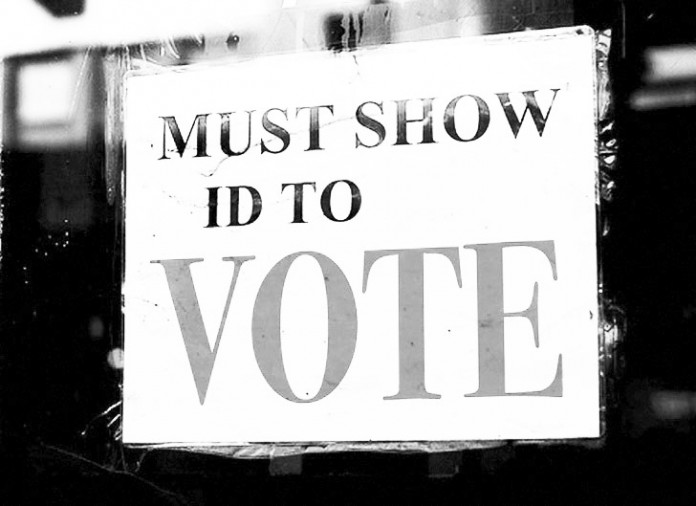Three University of California San Diego,UCSD, political scientists have published a paper that questions earlier research done on the impact of voter identification and registration laws on people of color, with an initial finding that voters of color are “increasingly, losing their place in the democratic process.”
The abstract to their report notes: “The proliferation of increasingly strict voter identification laws around the country has raise concerns about voter suppression and inequality. Although there are lots of reasons to suspect that these laws could harm groups like racial minorities and the poor, existing studies have generally failed to demonstrate a link between voter ID laws and voter turnout among these groups…We argue that because most of the studies occurred before states enacted the strictest photo identification requirements, they tend to uncover few effects. Focusing on the validated vote in recent elections using the Cooperative Congressional Election Study, we are able to offer a more definitive test. The analysis shows that strict photo identification laws have a differentially negative impact on the turnout of Hispanics, Blacks, and mixed-race Americans in primaries and general elections. Voter ID laws skew democracy in favor of whites and those on the political right.”
“For Latinos, Blacks, and multi-racial Americans, there are strong signs that strict photo identification laws decrease turnout.”
This was a key finding in a new working paper from UCSD researchers Zoltan Hajnal, Nazita Lajevardi, and Lindsay Nielson, who compared voter turnout rates between states with voter ID laws and those without. According to their analysis, no other demographic has as much difficulty as black and brown voters under these laws. “The results are clear,” the researchers state plainly in the paper.
Their study shows how wide the racial gaps are in voter turnout between states with and without voter ID requirements. Looking at general election outcomes from 2008 to 2012, the researchers found that Latino turnout was 10.3 points lower in states where photo ID is necessary to vote than for Latinos in states where it is not. For primary elections, they found that states with strict photo voter ID laws depressed Latino turnout by 6.3 points compared to Latinos in non-voter ID states, and depressed African-American turnout by 1.6 points.
When looking at the voter turnout rates between whites and non-whites under voter ID laws, the guidelines continued to have a dampening effect. The imbalance is intensified by voter ID requirements. In states where ID is not needed to vote, the gap between white and Latino turnout rates is just 5.3 percent in general elections. But that number jumps to 11.9 percent in states that do require ID. There’s a 4.8 percent gap between Latino and white turnout in non-voter ID states compared with a 8.5 percent gap between people of African descent and white voters in voter ID states.
White voters are “largely unaffected” by the laws, write the researchers, but voters of color have been “falling further and further behind and increasingly losing their place in the democratic process.”
From the report:
For the courts and for American democracy the core question should be—are these laws fair? Do they limit the access and participation of the nation’s most disadvantaged? Are these laws racially discriminatory? The findings presented here indicate that these laws do, in fact, have real consequences for the makeup of the voting population. Where they are enacted, racial and ethnic minorities are less apt to vote. The voices of Latinos, Blacks, and multi-racial Americans all become more muted and the relative influence of white Americans grows. An already significant racial skew in American democracy becomes all the more pronounced.
As conclusive as the study sounds, the researchers admit that it does not settle the matter for good: “Our analysis cannot definitively show a causal connection between voter ID laws and turnout,” reads the study. But their results bolster a large body of work that has found similar effects, including reports from the U.S. Government Accountability Office, the University of Florida voting rights expert Daniel “ElectionSmith” Smith, and even fivethirtyeight.com’s Nate Silver.
The section of the Voting Rights Act responsible for taming voter discrimination has been deactivated, thanks to the U.S. Supreme Court’s 2013 Shelby v. Holder decision. North Carolina used that occasion to create its own voter ID law, which includes other statutes that could make it even more difficult for minorities to vote. Civil rights groups are now in a legal fight with North Carolina over the new law and hope to have it removed before the state’s primary in March.
Voter ID isn’t the only controversial feature facing the electorate this year. As the UCSD political scientists point out in their study, there are also cuts to early voting periods, eliminating same-day voter registration, and confusion around proving one’s citizenship when registering to vote. There are unsettled questions about how all of these changes will affect voter participation, especially in combination.
SOURCE: voterIDhajnaletal.pdf






